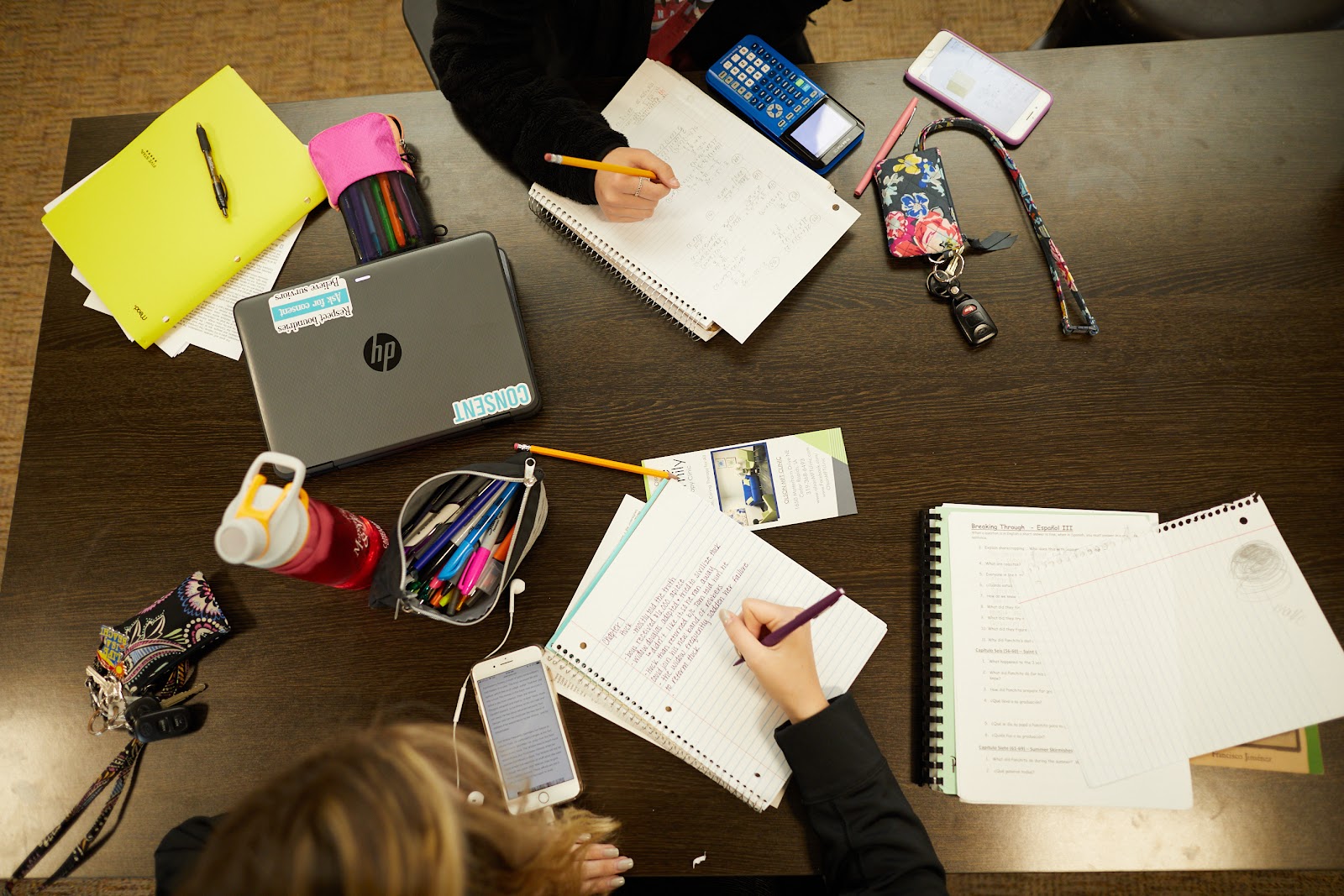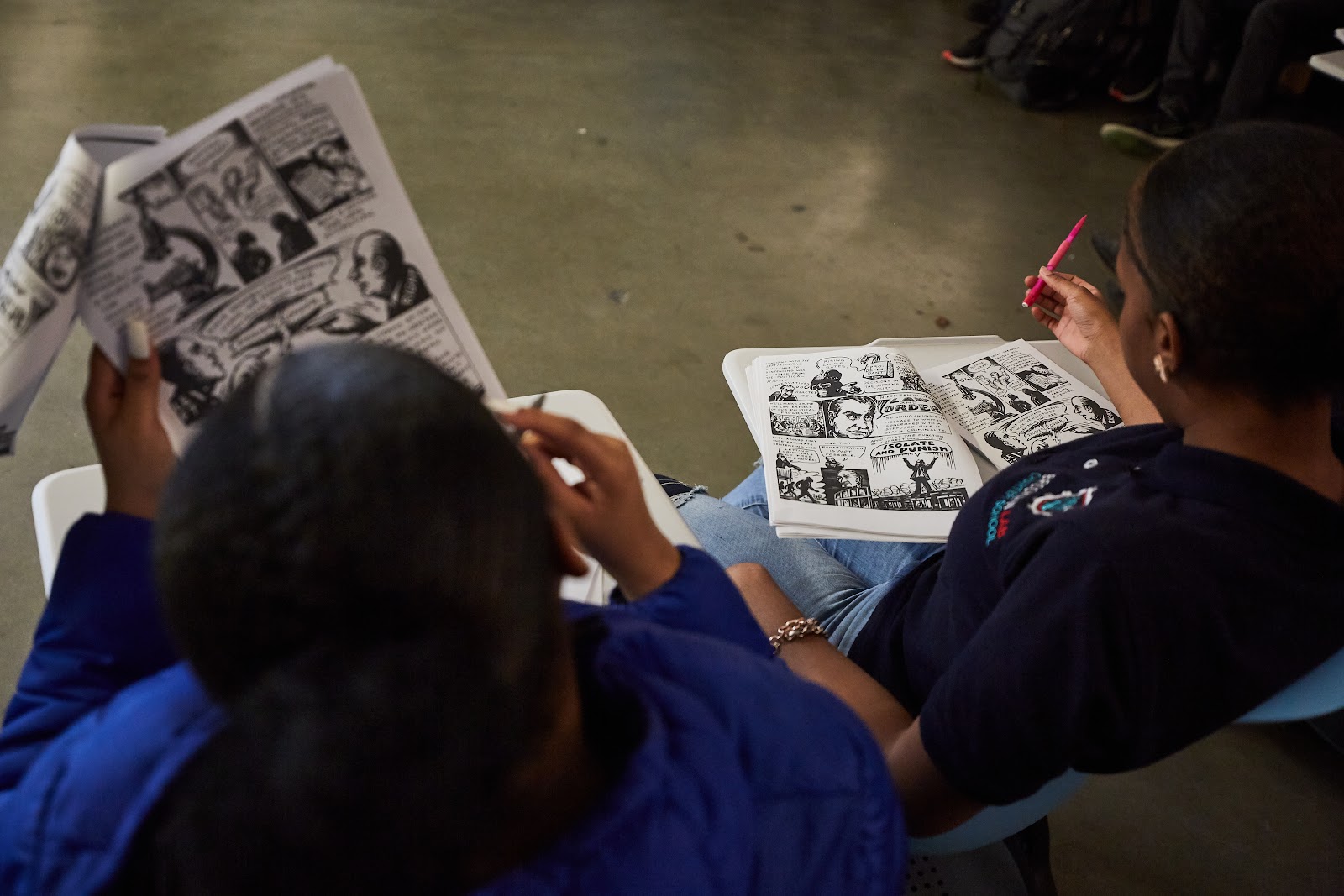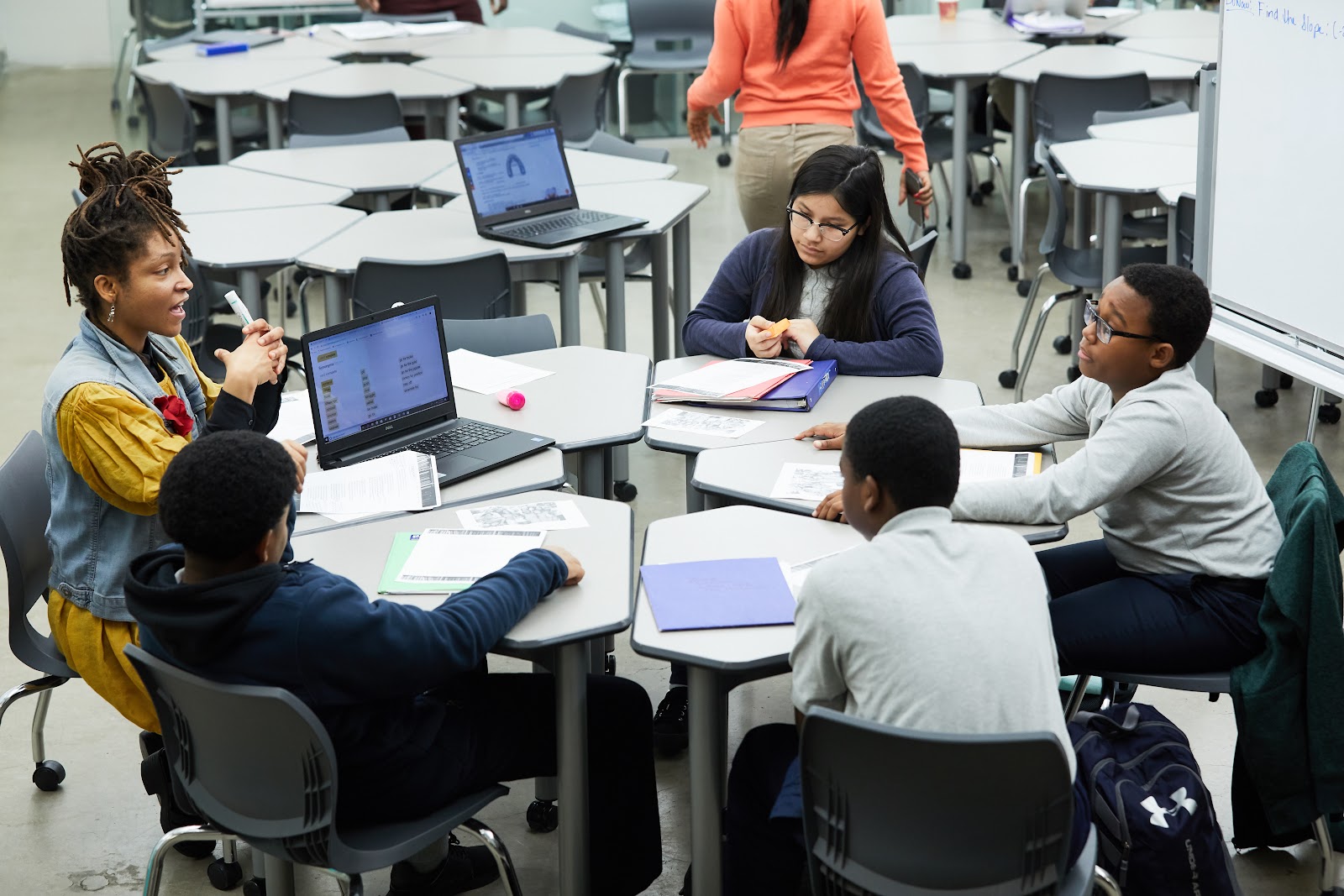The Four Steps of Reciprocal Teaching
Even for the most proficient readers in Suzanne Herko’s 11th-grade Humanities class at Gateway High…

Even for the most proficient readers in Suzanne Herko’s 11th-grade Humanities class at Gateway High School in San Francisco, California, tackling a complex text like “The Great Gatsby” can be daunting. But rather than give a lecture or assign a traditional essay for students to complete, Herko employs a collaborative model that encourages students to construct understanding together: reciprocal teaching.
Reciprocal Teaching: A Collaborative Learning Strategy
Reciprocal teaching is a learning strategy where students learn to build reading comprehension skills in small groups by practicing one of several reading skills with one another. It’s an instructional activity where students become teachers in small group sessions.
Educational researchers Annemarie Sullivan Palinscar and Ann L. Brow define reciprocal teaching as “a guided teaching strategy where small groups of students improve their reading comprehension by the scaffolded application of Predicting, Clarifying, Questioning, and Summarizing.”
In groups of three or four, students rotate through these four designated roles:
- The Summarizer: Highlights key points in the text for the group to understand.
- The Questioner: Poses questions about the text for the group to consider.
- The Clarifier: Addresses confusing parts of the text to answer questions raised.
- The Predictor: Makes evidence-based guesses about the text for the group to build inferences from.
When combined, these four skills are the foundation of good reading comprehension. For some students, routinely practicing these skills is necessary to reinforce strong comprehension skills.
By teaching students how these skills work and having them explicitly practice with peers in small groups, students can better learn how to develop tools they will eventually apply automatically.

What is Reciprocal Teaching?
Teachers initiate reciprocal teaching by modeling the four comprehension strategies through group instruction so students can see the process in action. Once students are comfortable and confident with the process, they then take turns leading their small groups through each step.
Reciprocal teaching improves reading skills and sharpens students’ metacognitive and critical thinking skills. Reciprocal teaching also capitalizes on two of XQ’s design principles—meaningful, engaged learning and youth voice and choice—by keeping students active and engaged in a classroom environment where students lead their learning.
What are the Four Steps of Reciprocal Teaching?
Reciprocal teaching not only increases student engagement in reading, but it can also increase comprehension by dividing comprehension strategies into four basic components and giving students time to practice them. Research also shows tremendous benefits to students when they learn with each through collaboration and peer feedback.
There are also special tools for teachers to help them deliver successful reciprocal teaching activities. Graphic organizers, like this Reciprocal Teaching Pyramid, provide a useful visual reminder of each student’s role and responsibilities. At the same time, this Reciprocal Teaching Checklist is designed for teachers to use as they work with students toward building comprehension.
Teachers should start by reading a section of a text and modeling each step. Then, divide students into small groups, each taking on one of the following roles.
Summarizing
Summarizing is arguably the most significant step. This skill involves students recapping the most important parts of the text they’ve read, both in writing and verbally.
As they read, students should take notes about important events and characters that appear in the text. Then, as a group, each member can share what they wrote to create a collective understanding of the text, a group roadmap.
To aid students in summarizing, consider guiding them with the following questions:
- Who did what, where, and when?
- What transpired in the beginning, the middle, and the end?
- What were the most important ideas from the paragraph, section, or chapter?
Questioning
Questioning is vital in ensuring students don’t gloss over confusing parts or elements they don’t understand. This could be as straightforward as noting down an unfamiliar word or pondering the motivations of a main character.
One helpful framing strategy is to encourage students to form questions based on what confused them and what piqued their curiosity. Prompt students to ask the essential questions of who, what, where, when, why, and how.
Clarifying
After questioning, the clarifying step addresses any confusing parts of the text and answers additional questions. Students can employ a variety of strategies—including rereading, decoding, and context clues—to identify meaning. They can also use resources like a dictionary.
Teachers can guide students in their search for answers by reflecting on three levels of questions and where to find answers. That includes:
- Right-There Questions: answers found in the text.
- Between-the-Lines Questions: answers found by using inference skills.
- Critical Thought Questions: answers that require students to use prior knowledge and their own opinions.
Predicting
While it may seem straightforward, predicting is a two-pronged approach in the context of reading comprehension. It involves students using their inference skills to create an educated guess based on a text in a broader and more immediate sense. (This is not to be confused with cueing, or predicting the meaning of a word, an ineffective reading strategy educators are now moving away from.)
Inference building is a vital reading skill where students go beyond the literal text to understand deeper meanings and connections. Stong inferences require students to deduce information that isn’t explicitly stated based on context and previous knowledge. Teaching inference building is crucial because it enhances reading comprehension, promotes critical thinking, and prepares students for real-world solutions where they’ll need to interpret and analyze information. We’ve identified many of these skills as key competencies in our XQ Learner Outcomes.
The first part involves predicting what will happen overall in the reading material. Students can use various clues to make these predictions, like investigating the cover art, the title of the book, or even a summary.
The second part involves predicting what will happen in the immediate future, such as the next section or chapter of the reading material. Students should look for clues embedded in the dialogue, imagery, and literary techniques like foreshadowing to construct their predictions. Using evidence to support their predictions helps students avoid making baseless guesses that don’t align with the text or prevent them from thinking intentionally or critically.
For example, if students are reading “The Diary of Anne Frank,” a prediction like, “This book is about a girl who keeps a diary,” is overly simplistic. Instead, encourage students to think more deeply by activating any prior knowledge as well as the summary of the book to formulate a more nuanced prediction.
While reading, students should monitor their predictions to assess their accuracy—a fantastic opportunity to practice their metacognitive skills and reflect more profoundly on their thinking process!
What are the Benefits of Reciprocal Teaching?
Research on reciprocal teaching has shown improvements in student reading comprehension skills and increased engagement as students hold each other accountable in their small groups. It has also been shown to be effective for English language learners or those with learning challenges.
Reciprocal teaching also benefits students through the following:
- Improved literacy: Instead of skipping over words or sections they don’t understand, students work collaboratively to generate an understanding.
- Increased engagement: Students actively look for clues and details to support their role and engage deeply with their peers, keeping them focused on the text and committed to group success.
- Better reading comprehension: By practicing Predicting, Clarifying, Questioning, and Summarizing, students are strengthening the four building blocks of reading and how to understand ideas presented in a text.
- Independent learning: Working in groups, students can clearly see the steps needed for good reading comprehension, which they can apply to their independent reading.

Implementing Reciprocal Teaching in High School
High school is not too late for reciprocal teaching. Teachers in the upper grades can think of it as a kind of reading apprenticeship model. In a video observation from WestEd, high school teacher Suzanne Herko described the benefits of reciprocal teaching in the high school classroom. She explained how teachers are always present, answering questions, and showings students how to incorporate metacognitive strategies when reading. These skills appear in reciprocal activities where students learn in a peer-to-peer setting.
While reciprocal teaching is often a model in elementary and middle school classrooms, it remains a powerful tool for high school classes regardless of the discipline. Older students can use the model to build independence and hone their metacognitive processes in their reading. Students will need these skills in the classroom, college, and future careers.
“Oftentimes, students have this idea that when you read something, either you get it or you don’t get it,” Hersko said. “So, I see them being more metacognitive in understanding what they need to do in order to make sense of stuff.”
Project-Based Learning and Reciprocal Teaching
In many ways, reciprocal teaching perfectly complements project-based learning (PBL), a method in which students learn by actively engaging in real-world projects. During a project, students must identify a problem, make hypotheses, collect data, and communicate with team members to try and propose a solution.
PBL provides an ideal venue for students to hone the skills learned through reciprocal teaching, including summarizing, asking questions, clarifying, and making predictions. Reciprocal models are great for a variety of subject matters beyond English and reading courses. Whether using it to learn a new math concept, conduct a science experiment, or discuss a history topic in social studies, this active learning model is an appropriate instructional strategy for all teachers to integrate into practice.
Accommodations to Support Student Learning
Reciprocal teaching is also a great way to support English language learners and incorporate accommodations for students with learning disabilities and other learning challenges.
When differentiating for English language learners, it’s even more critical for teachers to model each step and double-check for understanding.
There are more additional supports teachers can include for both reciprocal and other instructional models:
- Offering clues if a student struggles to summarize, like pointing out examples of topic sentences or details, can help to build understanding.
- Using graphic representations (a magnifying glass for the clarifier, a crystal ball for the predictor) for cues about student roles.
- Incorporating multisensory approaches to support learning with manipulatives, realia, or physical cues to signal understanding.
- Grouping students into mixed reading levels so they constantly learn from each other rather than compete.
- Providing question stems to get students started, like “How are two characters alike/different?”
Key Takeaways
Reciprocal teaching is an example of differentiated instruction that can help high school teachers rethink their classroom instruction to ensure more meaningful, engaged learning. It’s a powerful tool that fosters student engagement, enhances reading comprehension, and promotes independent learning.
While reciprocal instruction has been around for decades, it remains an effective collaborative learning strategy that empowers students to take ownership of their learning. When rethinking high school, consider how reciprocal teaching can show up in your projects and classroom to bolster students’ critical thinking and create a more interactive, student-centered learning experience.
Create Transformation: High school transformation is necessary, possible, and already underway! Stay updated on innovative changes from across the country by subscribing to our XQ Xtra Newsletter. Get the latest success stories, strategies, and resources delivered straight to your inbox, and join us in reimagining the high school experience for every student.
Image at top: Students at Iowa BIG dive deep into collaborative learning with each other. (Photo by Chris Chandler)









